Heavy Precipitation Systems in Calabria Region (Southern Italy): High-Resolution Observed Rainfall and Large-Scale Atmospheric Pattern Analysis
Abstract
1. Introduction
- a deeper statistical analysis of the rain gauge data, at a finer temporal resolution, is performed, and a larger period of investigation is considered (14 years);
- with the proposed modeling approach, the meteorological conditions that influence the heavy rain events and their spatiotemporal behavior are analyzed. Obviously, this study should not be considered as an alternative to Numerical Weather Prediction models. It represents a survey that can provide very useful information in the more general topic regarding analysis of rainfall fields, mainly in order to evaluate the role of the considered synoptic parameters as possible precursors. In particular, noticeable improvements can be obtained in the definition of design rainfall scenarios in space and time, with consequent progress for evaluation of risk scenarios related to induced phenomena (mainly floods and landslides).
- in the first part, the authors selected and regrouped heavy events by using sub-hourly data series from a rain gauge network;
- in the second part, the authors investigated the relationships among the selected events and the main synoptic atmospheric patterns derived by the Reanalysis (ERA5) dataset of the European Centre for Medium-Range Weather Forecasts (ECMWF), in order to assess the possible large-scale scenarios which can induce heavy rainfall events in the study area.
2. Materials and Methods
2.1. Study Area
2.2. Selection and Classification of Rain Events
- starts when a value higher than IMIN = 5 mm/20 min (minimum threshold) is observed in at least one rain gauge (located in the spatial domain), and no station records a value greater than or equal to the aforementioned threshold IMIN in the previous 6 h;
- ends when all the rain gauges in the spatial domain measure values that are lower than IMIN after the rain peak (which has to be greater than or equal to IEVE), and no station recorded values higher than IMIN in the following 6 h.
- the duration d (h);
- the maximum observed value of rainfall amount (mm) in 20 min, from rain gauge network;
- the maximum observed values of cumulative rainfall amount (mm) from rain gauge network, aggregated along the whole event duration and on specific durations (1, 3, 6, 12 and 24 h);
- the associated map of the rainfall field, which was obtained by using the Inverse Distance Weighting (IDW) method [30] for a 1-km resolution grid, and by considering the cumulative rainfall amounts, over the whole event duration, from rain gauge data. IDW is one of the most used deterministic interpolation methods to reproduce rainfall fields. Several studies compared different interpolation techniques concerning rainfall data, and asserted that IDW method is comparable or even more suitable than other techniques (including geostatistics approaches) for finer temporal resolutions, such as a daily resolution or less [31,32,33,34,35,36]. Moreover, having to perform a large number of interpolations, the use of IDW requires shorter computation times than others [33,37];
- from the obtained rainfall field, the maximum value of cumulative rainfall amount (mm) was calculated; it was aggregated on several spatial and time resolutions. The authors considered nxn pixel—moving square grids, with n = 1, 5, 11, 21, 45 and 51 km, and durations equal to 1, 3, 6, 12 and 24 h.
- an event was classified as SS if the associated map of rainfall field does not present localized peaks surrounded by areas without a significant precipitation, and the spatial extension of this rainfall field is at least 1000 km2 [5];
- the other events were classified as CSLE.
- is the maximum value of the observed cumulative rainfall amount in a rain gauge;
- is the maximum value of the average rainfall accumulation over an assigned nxn-pixel area A, through a moving window over the 1-km grid of the associated interpolated rainfall field.
2.3. The ERA5 Dataset
3. Results
3.1. Results from Rain Gauge Data
- the Decay Ratio (DR, Equation (2)), in which the authors assumed for area A a square with n = 51 km [52]. A 51-km side implies A = 2525 km2; this value should not make confusion, compared with 1000 km2 (i.e., the assumed minimum extension of a strictly positive rainfall field characterizing a SS event, [5]), because two or more isolated peaks could occur inside this larger area A (i.e., a plausible situation for a CSLE event).
- Event duration d (h).
- (mm/h), evaluated as , i.e., the ratio between the maximum value of the observed cumulative rainfall amount and the event duration.
- are characterized by values for d and which are representative of a CSLE event, although they present DR values > 0.25 and shapes of the rainfall field which are typical of a SS event;
- if a SS event presents values for d and which are representative of a CSLE event or, for large durations (d > 12 h), values greater than 140 mm/day (this is the maximum reference value in [6] for identifying an ordinary SS), that means very high values for , then it is classified as VHSS (Very Heavy Synoptic Systems);
- in the other cases, it is indicated as HSS (Heavy Synoptic Systems).
3.2. ERA5 Large Scale Atmospheric Fields
- the events which are greater than the sample 90% percentile in at-least one distribution and then;
- from this previous filter, heavy rain events with at least 60 mm in 24 h [54], observed in one rain gauge.
3.3. Heavy Synoptic Systems (HSS)
3.4. Very Heavy Synoptic Systems (VHSS)
3.5. Convective Systems with Local Effects (CSLE)
3.6. Analysis of Anomalies
4. Discussion
- the investigated synoptic systems are mainly characterized by negative anomalies for geopotential height (between −80 and −100 m) and sea level pressure (up to −6 hPa) in the central-western Mediterranean. For the VHSS, the region of greatest anomaly is more displaced to west respect to HSS, and the low-level winds reach Calabria region coming from S-SE, facilitating the development of favourable conditions for heaviest rainfall on the eastern side of the region. In the HSS case the rainfall is favoured on the western coast of the region, in agreement with the observations (Figure 8a,b);
- the investigated convective systems are predominantly related to the low-level temperature that presents a positive anomaly everywhere (locally up to 3 K), causing localized convection development and major rainfall in correspondence of the orographic reliefs (Figure 8c).
5. Conclusions
- Areal Reduction Factors (ARFs) for numerically characterizing the differences in scaling (in space and time) between Convective Systems with Local Effects (CSLE) and Synoptic Systems (SS);
- Rainfall Intensity and Cumulative Rainfall amounts for furtherly discriminating Very Heavy Synoptic Systems (VHSS) from Heavy Synoptic Systems (HSS).
Author Contributions
Funding
Acknowledgments
Conflicts of Interest
Appendix A
| Start | End | Max Peak (mm/20 min) | Max Peak Rain Gauge | Max Cum (mm) | Max Cum Rain Gauge |
|---|---|---|---|---|---|
| 2 September 2002 12:00 | 2 September 2002 18:40 | 36.4 | Tiriolo | 118.4 | Tiriolo |
| 27 September 2003 14:00 | 27 September 2003 15:20 | 22.0 | Staiti | 78.4 | Staiti |
| 14 October 2003 12:40 | 15 October 2003 18:00 | 38.0 | Petronà | 237.0 | Petronà |
| 29 October 2003 23:20 | 30 October 2003 17:20 | 36.4 | Lagonegro | 95.2 | Lagonegro |
| 22 November 2003 3:20 | 22 November 2003 11:00 | 27.0 | San Luca—Santuario di Polsi | 139.2 | Santa Cristina d’Aspromonte |
| 11 December 2003 0:00 | 13 December 2003 4:40 | 28.6 | Antonimina—Canolo Nuovo | 588.2 | San Luca—Santuario di Polsi |
| 3 June 2004 7:00 | 3 June 2004 11:20 | 17.8 | C.le Castrocucco | 105.6 | C.le Castrocucco |
| 20 September 2004 2:40 | 21 September 2004 1:20 | 42.0 | Cropalati | 137.4 | Monasterace—Punta Stilo |
| 3 November 2004 14:40 | 5 November 2004 8:20 | 27.8 | Tarsia | 165.0 | Tarsia |
| 12 November 2004 11:40 | 13 November 2004 5:20 | 41.6 | Decollatura | 222.4 | Parenti |
| 6 September 2005 13:00 | 6 September 2005 16:40 | 28.6 | Arena | 80.6 | Arena |
| 22 October 2005 18:00 | 23 October 2005 1:00 | 51.2 | Molochio | 224.0 | Molochio |
| 2 January 2006 1:00 | 2 January 2006 6:00 | 47.4 | Lagonegro | 70.2 | Lagonegro |
| 3 July 2006 5:00 | 3 July 2006 14:00 | 45.0 | Vibo Valentia | 202.6 | Vibo Valentia |
| 8 July 2006 12:40 | 8 July 2006 18:00 | 35.2 | Roccabernarda—Serrarossa | 69.6 | Serra San Bruno |
| 25 September 2006 22:20 | 27 September 2006 18:40 | 43.0 | Monasterace—Punta Stilo | 131.0 | Giffone |
| 22 December 2006 2:00 | 23 December 2006 16:40 | 24.6 | Palermiti | 243.2 | Corigliano Calabro |
| 27 May 2007 21:40 | 28 May 2007 11:20 | 33.4 | Gioia Tauro | 78.8 | Castrovillari—Camerata |
| 7 October 2007 1:40 | 7 October 2007 17:20 | 30.0 | Belvedere Marittimo | 103.0 | Belvedere Marittimo |
| 28 October 2008 18:40 | 28 October 2008 23:00 | 56.8 | Gioiosa Ionica | 84.0 | Gioiosa Ionica |
| 07 November 2008 4:20 | 07 November 2008 9:20 | 18.6 | Stignano | 81.0 | Stignano |
| 28 November 2008 12:40 | 28 November 2008 22:00 | 21.2 | Antonimina—Canolo Nuovo | 180.4 | Petilia Policastro—Pagliarelle |
| 03 December 2008 16:20 | 03 December 2008 12:20 | 20.0 | Stignano | 120.4 | Cropalati |
| 10 December 2008 13:40 | 12 December 2008 5:40 | 23.0 | Spineto | 389.2 | Santa Cristina d’Aspromonte |
| 9 January 2009 15:40 | 10 January 2009 0:40 | 25.4 | Corigliano Calabro | 165.8 | Corigliano Calabro |
| 13 January 2009 3:20 | 13 January 2009 22:20 | 21.2 | Santa Cristina d’Aspromonte | 283.8 | Santa Cristina d’Aspromonte |
| 21 September 2009 23:20 | 23 September 2009 18:20 | 30.0 | Santa Caterina dello Ionio | 301.6 | Santa Caterina dello Ionio |
| 24 September 2009 13:40 | 27 September 2009 14:40 | 42.6 | Chiaravalle Centrale | 544.0 | Petronà |
| 23 October 2009 16:00 | 25 October 2009 12:20 | 43.4 | Monasterace—Punta Stilo | 126.2 | Monasterace—Punta Stilo |
| 10 November 2009 14:00 | 11 November 2009 22:40 | 16.8 | Rosarno | 193.0 | Rosarno |
| 14 December 2009 8:20 | 15 December 2009 4:40 | 16.0 | Santa Cristina d’Aspromonte | 119.6 | Santa Cristina d’Aspromonte |
| 26 January 2010 18:40 | 27 January 2010 20:00 | 25.0 | Plati’ | 360.0 | Fabrizia—Cassari |
| 9 March 2010 16:20 | 10 March 2010 10:40 | 21.4 | Cropani | 260.8 | Cotronei |
| 03 September 2010 4:40 | 04 September 2010 10:00 | 40.8 | Reggio Calabria | 155.0 | San Mauro Marchesato |
| 6 October 2010 5:40 | 6 October 2010 23:20 | 20.8 | Laino Borgo | 101.8 | Laino Borgo |
| 18 October 2010 12:20 | 19 October 2010 20:20 | 30.4 | Bagnara Calabra | 218.0 | Serralta |
| 2 November 2010 8:20 | 2 November 2010 16:00 | 25.2 | Gambarie d’Aspromonte | 188.6 | Rizziconi |
| 14 October 2011 8:40 | 15 October 2011 5:00 | 39.2 | Ciro’ Marina—Punta Alice | 67.6 | Sant’Agata del Bianco |
| 23 October 2011 4:20 | 23 October 2011 18:20 | 25.6 | Cariati Marina | 85.0 | Cariati Marina |
| 11 November 2011 14:40 | 12 November 2011 2:40 | 26.8 | Scilla—Tagli | 114.2 | Scilla—Solano |
| 22 November 2011 10:00 | 23 November 2011 3:00 | 43.8 | Cittanova | 353.4 | Cittanova |
| 23 July 2012 20:00 | 24 July 2012 3:40 | 36.8 | Oriolo | 89.0 | Oriolo |
| 13 September 2012 11:40 | 15 September 2012 2:00 | 37.6 | Cetraro Superiore | 142.2 | Cetraro Superiore |
| 15 November 2012 12:00 | 16 November 2012 18:00 | 21.4 | Monasterace—Punta Stilo | 168.2 | Santa Caterina dello Ionio |
| 17 November 2012 0:40 | 18 November 2012 22:20 | 27.0 | Ciro’ Marina—Punta Alice | 167.4 | Palermiti |
| 19 November 2012 12:20 | 21 November 2012 16:20 | 17.6 | Roseto Capo Spulico | 182.8 | Rosarno |
| 8 July 2013 11:00 | 8 July 2013 16:40 | 28.8 | San Sosti | 71.2 | Nocelle—Arvo |
| 7 October 2013 9:00 | 7 October 2013 15:00 | 34.4 | San Mauro Marchesato | 99.2 | San Mauro Marchesato |
| 8 October 2013 13:00 | 8 October 2013 18:40 | 30.6 | Ciro’ Marina—Punta Alice | 71.4 | Ciro’ Marina—Punta Alice |
| 15 October 2013 23:20 | 16 October 2013 22:40 | 39.2 | Palermiti | 90.4 | Serralta |
| 12 November 2013 20:40 | 14 November 2013 12:00 | 30.6 | Soverato Marina | 109.6 | Chiaravalle Centrale |
| 15 November 2013 12:40 | 16 November 2013 17:20 | 22.6 | Borgia— Roccelletta | 146.0 | Cerenzia |
| 18 November 2013 23:00 | 19 November 2013 11:00 | 38.4 | Serra San Bruno | 215.2 | Ciro’ Marina—Punta Alice |
| 31 January 2014 18:00 | 2 February 2014 14:40 | 23.2 | Palermiti | 447.6 | Petilia Policastro—Pagliarelle |
| 21 February 2014 4:20 | 21 February 2014 7:20 | 22.0 | Scilla—Tagli | 70.2 | Scilla—Tagli |
| 1 September 2014 16:00 | 2 September 2014 9:40 | 22.6 | Vibo Valentia—Longobardi | 106.2 | Sinopoli |
| 13 September 2014 4:00 | 13 September 2014 8:00 | 39.0 | Belvedere Marittimo | 66.4 | Belvedere Marittimo |
| 4 November 2014 21:00 | 5 November 2014 23:00 | 45.4 | Roccella Ionica | 271.4 | Plati’ |
| 6 November 2014 11:40 | 8 November 2014 12:20 | 25.8 | Cropani | 265.8 | Cardeto |
| 21 June 2015 10:00 | 21 June 2015 20:40 | 19.4 | Mongiana | 73.2 | Mongiana |
| 9 August 2015 12:00 | 9 August 2015 16:00 | 29.2 | Arena | 80.4 | Arena |
| 11 August 2015 10:00 | 12 August 2015 23:00 | 39.4 | Oriolo | 255.2 | Corigliano Calabro |
| 13 August 2015 13:20 | 13 August 2015 14:20 | 39.2 | Plati’ | 100.8 | Plati’ |
| 20 September 2015 11:20 | 21 September 2015 7:00 | 37.2 | Antonimina—Canolo Nuovo | 176.0 | Antonimina—Canolo Nuovo |
| 7 October 2015 6:40 | 7 October 2015 18:00 | 38.4 | Tortora | 67.6 | San Sosti |
| 20 October 2015 13:00 | 20 October 2015 20:00 | 17.4 | Ciro’ Marina—Punta Alice | 91.4 | Ciro’ Marina—Punta Alice |
| 30 October 2015 19:20 | 2 November 2015 2:00 | 30.2 | Ardore Superiore | 717.2 | Chiaravalle Centrale |
References
- Houze, R.A., Jr. Structures of atmospheric precipitation systems—A global survey. Radio Sci. 1981, 16, 671–689. [Google Scholar] [CrossRef]
- De Luca, C.; Furcolo, P.; Rossi, F.; Villani, P.; Vitolo, C. Extreme Rainfall in Mediterranean. In Proceedings of the STAHY 2010 International Workshop Advances In Statistical Hydrology, Taormina, Italy, 23–25 May 2010. [Google Scholar]
- Ulbrich, U.; Lionello, P.; Belusic, D.; Jacobeit, J.; Knippertz, P.; Kuglitsch, F.G.; Leckebusch, G.C.; Luterbacher, J.; Maugeri, M.; Maheras, P.; et al. Climate of the Mediterranean: Synoptic Patterns, Temperature, Precipitation, Winds, and Their Extremes. In Climate of the Mediterranean Region—From the Past to the Future; Lionello, P., Ed.; Elsevier: Sydney, Australia, 2012; Volume 5, pp. 301–346. [Google Scholar] [CrossRef]
- Lionello, P.; Trigo, I.F.; Gil, V.; Liberato, M.L.R.; Nissen, K.M.; Pinto, J.G.; Raible, C.C.; Reale, M.; Tanzarella, A.; Trigo, M.R.; et al. Objective climatology of cyclones in the Mediterranean region: A consensus view among methods with different system identification and tracking criteria. Tellus A 2016, 68, 29391. [Google Scholar] [CrossRef]
- Willems, P. A spatial rainfall generator for small spatial scales. J. Hydrol. 2001, 252, 126–144. [Google Scholar] [CrossRef]
- Rossi, F.; Scannapieco, G.; Villani, P. Una proposta operativa per la rivalutazione del rischio idrogeologico di alluvione in Italia (in Italian). In Proceedings of the XXXV Convegno di Idraulica e Costruzioni Idrauliche, Bologna, Italy, 14–16 September 2016. [Google Scholar]
- Waymire, E.; Gupta, V.K.; Rodriguez-Iturbe, I. A spectral theory of rainfall intensity at the meso-b scale. Water Resour. Res. 1984, 20, 1453–1465. [Google Scholar] [CrossRef]
- Reale, O.; Atlas, R. Tropical Cyclone–Like Vortices in the Extratropics: Observational Evidence and Synoptic Analysis. Weather Forecast. 2001, 16, 7–34. [Google Scholar] [CrossRef]
- Tous, M.; Romero, R. Medicanes: Cataloguing criteria and exploration of meteorological environments. Tethys 2011, 8, 53–61. [Google Scholar] [CrossRef]
- Tous, M.; Romero, R. Meteorological environments associated with medicane development. Int. J. Clim. 2012, 33, 1–14. [Google Scholar] [CrossRef]
- Cavicchia, L.; Von Storch, H. The simulation of medicanes in a high-resolution regional climate model. Clim. Dyn. 2011, 39, 2273–2290. [Google Scholar] [CrossRef]
- Miglietta, M.M.; Laviola, S.; Malvaldi, A.; Conte, D.; Levizzani, V.; Prince, C. Analysis of tropical-like cyclones over the Mediterranean sea through a combined modeling and satellite approach. Geophys. Res. Lett. 2013, 40, 2400–2405. [Google Scholar] [CrossRef]
- Pelosi, A.; Furcolo, P.; Rossi, F.; Villani, P. The characterization of extraordinary extreme events (EEEs) for the assessment of design rainfall depths with high return periods. Hydrol. Process. 2020. [Google Scholar] [CrossRef]
- Libertino, A.; Ganora, D.; Claps, P. Technical note: Space-time analysis of rainfall extremes in Italy: Clues from a reconciled dataset. Hydrol. Earth Syst. Sci. 2018, 22, 2705–2715. [Google Scholar] [CrossRef]
- Castellarin, A.; Merz, R.; Blöschl, G. Probabilistic envelope curves for extreme rainfall events. J. Hydrol. 2009, 378, 263–271. [Google Scholar] [CrossRef]
- Lana, A.; Campins, J.; Genovés, A.; Jansà, A. Atmospheric patterns for heavy rain events in the Balearic Islands. Adv. Geosci. 2007, 12, 27–32. [Google Scholar] [CrossRef][Green Version]
- Martínez, C.; Campins, J.; Jansà, A.; Genovés, A. Heavy rain events in the Western Mediterranean: An atmospheric pattern classification. Adv. Sci. Res. 2008, 2, 61–64. [Google Scholar] [CrossRef][Green Version]
- Romero, R.; Ramis, C.; Alonso, S.; Doswell, C.A., III; Stensrud, D.J. Mesoscale Model Simulations of Three Heavy Precipitation Events in the Western Mediterranean Region. Mon. Weather Rev. 1998, 126, 1859–1881. [Google Scholar] [CrossRef]
- Llasat, M.C.; Llasat-Botija, M.; Petrucci, O.; Pasqua, A.A.; Rosselló, J.; Vinet, F.; Boissier, L. Towards a database on societal impact of Mediterranean floods within the framework of the HYMEX project. Nat. Hazards Earth Syst. Sci. 2013, 13, 1337–1350. [Google Scholar] [CrossRef]
- Federico, S.; Avolio, E.; Pasqualoni, L.; De Leo, L.; Sempreviva, A.M.; Bellecci, C. Preliminary results of a 30-year daily rainfall data base in southern Italy. Atmos. Res. 2009, 94, 641–651. [Google Scholar] [CrossRef]
- Federico, S.; Pasqualoni, L.; Avolio, E.; Bellecci, C. Brief communication “Calabria daily rainfall from 1970 to 2006”. Nat. Hazards Earth Syst. Sci. 2010, 10, 717–722. [Google Scholar] [CrossRef]
- Avolio, E.; Federico, S.; Miglietta, M.M.; Lo Feudo, T.; Calidonna, C.R.; Sempreviva, A.M. Sensitivity analysis of WRF model PBL schemes in simulating boundary-layer variables in southern Italy: An experimental campaign. Atmos. Res. 2017, 192, 58–71. [Google Scholar] [CrossRef]
- Avolio, E.; Federico, S. WRF simulations for a heavy rainfall event in southern Italy: Verification and sensitivity tests. Atmos. Res. 2018, 209, 14–35. [Google Scholar] [CrossRef]
- Federico, S.; Avolio, E.; Pasqualoni, L.; Bellecci, C. Atmospheric patterns for heavy rain events in Calabria. Nat. Hazards Earth Syst. Sci. 2008, 8, 1173–1186. [Google Scholar] [CrossRef]
- Pielke, R.A.; Cotton, W.R.; Walko, R.L.; Tremback, C.J.; Lyons, W.A.; Grasso, L.D.; Nicholls, M.E.; Murran, M.D.; Wesley, D.A.; Lee, T.H.; et al. A comprehensive meteorological modelling system-RAMS. Meteorol. Atmos. Phys. 1992, 49, 69–91. [Google Scholar] [CrossRef]
- Cotton, W.R.; Pielke, R.A., Sr.; Walko, R.L.; Liston, G.E.; Tremback, C.J.; Jiang, H.; McAnelly, R.L.; Harrington, J.Y.; Nicholls, M.E.; Carrio, G.G.; et al. RAMS 2001: Current status and future directions. Meteor. Atmos. 2003, 82, 5–29. [Google Scholar] [CrossRef]
- Lionello, P.; Malanotte-Rizzoli, P.; Boscolo, R.; Alpert, P.; Artale, V.; Li, L.; Luterbacher, J.; May, W.; Trigo, W.; Tsimplis, M.; et al. The Mediterranean climate: An overview of the main characteristics and issues. In Mediterranean Climate Variability, Developments in Earth and Environmental Sciences; Lionello, P., Malanotte-Rizzoli, P., Boscolo, R., Eds.; Elsevier: Amsterdam, The Netherlands, 2006; Volume 4, pp. 1–26. [Google Scholar] [CrossRef]
- Llasat, M.C. An objective classification of rainfall events on the basis of their convective features. Application to rainfall intensity in the north-east of Spain. Int. J. Clim. 2001, 21, 1385–1400. [Google Scholar] [CrossRef]
- Wischmeier, W.H.; Smith, D.D. Predicting Rainfall Erosion Losses—A Guide to Conservation Planning; Science and Education Administration: Hyattsville, MD, USA; USDA: Washington, DC, USA, 1978.
- Shepard, D. A two-dimensional interpolation function for irregularly-spaced data. In Proceedings of the 1968 ACM National Conference, New York, NY, USA, 27–29 August 1968. [Google Scholar] [CrossRef]
- Dirks, K.N.; Hay, J.E.; Stow, C.D.; Harris, D. High-resolution studies of rainfall on Norfolk Island. Part 2: Interpolation of rainfall data. J. Hydrol. 1998, 208, 187–193. [Google Scholar] [CrossRef]
- Kurtzman, D.; Navon, S.; Morin, E. Improving interpolation of daily precipitation for hydrologic modeling: Spatial patterns of preferred interpolators. Hydrol. Process. 2009, 23, 3281–3291. [Google Scholar] [CrossRef]
- Ly, S.; Charles, C.; Degré, A. Geostatistical interpolation of daily rainfall at catchment scale: The use of several variogram models in the Ourthe and Ambleve catchments, Belgium. Hydrol. Earth Syst. Sci. 2011, 15, 2259–2274. [Google Scholar] [CrossRef]
- Yang, X.; Xie, X.; Liu, D.L.; Ji, F.; Wang, L. Spatial interpolation of daily rainfall data for local climate impact assessment over greater Sydney region. Adv. Meteorol. 2015, 2015. [Google Scholar] [CrossRef]
- Chen, T.; Ren, L.; Yuan, F.; Yang, X.; Jiang, S.; Tang, T.; Liu, Y.; Zhao, C.; Zhang, L. Comparison of spatial interpolation schemes for rainfall data and application in hydrological modelling. Water 2017, 9, 342. [Google Scholar] [CrossRef]
- Cheng, M.; Wang, Y.; Engel, B.; Zhang, W.; Peng, H.; Chen, X.; Xia, H. Performance Assessment of Spatial Interpolation of Precipitation for Hydrological Process Simulation in the Three Gorges Basin. Water 2017, 9, 838. [Google Scholar] [CrossRef]
- Caruso, C.; Quarta, F. Interpolation methods comparison. Comput. Math. Appl. 1998, 35, 109–126. [Google Scholar] [CrossRef]
- Wilks, D.S. Statistical Methods in the Atmospheric Sciences: An Introduction; International Geophysics Series; Academic Press: St Louis, MO, USA, 1995; p. 59. [Google Scholar]
- Richman, M.B. Rotation of principal components. Int. J. Clim. 1986, 6, 293–335. [Google Scholar] [CrossRef]
- Kalkstein, S.L.; Tan, G.; Skindlov, J.A. An evaluation of three clustering procedures for use in synoptic climatological classification. J. Clim. Appl. Meteorol. 1987, 25, 717–730. [Google Scholar] [CrossRef]
- Gong, X.; Richman, M.B. On the application of cluster analysis to growing season precipitation data in North America east of the Rockies. J. Clim. 1995, 8, 897–931. [Google Scholar] [CrossRef]
- Von Storch, H.; Zwiers, F.W. Statistical Analysis in Climate Research; Cambridge University Press: Cambridge, UK, 1999. [Google Scholar] [CrossRef]
- Barry, R.G.; Carleton, A.M. Synoptic and Dynamic Climatology; Routledge: London, UK, 2001. [Google Scholar] [CrossRef]
- Yarnal, B.; Comrie, A.C.; Frakes, B.; Brown, D.P. Developments and prospects in synoptic climatology. Int. J. Clim. 2001, 21, 1923–1950. [Google Scholar] [CrossRef]
- Zwiers, F.W.; Von Storch, H. On the role of statistics in climate research. Int. J. Clim. 2004, 24, 665–680. [Google Scholar] [CrossRef]
- Austin, P.M.; Houze, R.A., Jr. Analysis of the structure of precipitation patterns in New England. J. Appl. Meteorol. 1972, 11, 926–935. [Google Scholar] [CrossRef]
- Moseley, C.; Berg, P.; Haerter, J.O. Probing the precipitation life cycle by iterative rain cell tracking. J. Geophys. Res. Atmos. 2013, 118, 13361–13370. [Google Scholar] [CrossRef]
- Berg, P.; Moseley, C.; Haerter, J.O. Strong increase in convective precipitation in response to higher temperatures. Nat. Geosci. 2013, 6, 181–185. [Google Scholar] [CrossRef]
- Wright, D.B.; Smith, J.A.; Baeck, M.L. Critical examination of area reduction factors. J. Hydrol. Eng. 2014, 19, 769–776. [Google Scholar] [CrossRef]
- Hersbach, H.; Bell, W.; Berrisford, P.; Horányi, A.; Sabater, J.M.; Nicolas, J.; Radu, R.; Schepers, D.; Simmons, A.; Soci, C.; et al. Global reanalysis: Goodbye ERA-Interim, hello ERA5. In Meteorology Section of ECMWF Newsletter No. 159; Spring: Berlin/Heidelberg, Germany, 2019; pp. 17–24. [Google Scholar] [CrossRef]
- Mastrangelo, D.; Horvat, K.; Riccio, A.; Miglietta, M.M. Mechanism for convection development in a long lasting heavy precipitation event over southeastern Italy. Atmos. Res. 2011, 10, 586–602. [Google Scholar] [CrossRef]
- Eggert, B.; Berg, P.; Haerter, J.O.; Jacob, D.; Moseley, C. Temporal and spatial scaling impacts on extreme precipitation. Atmos. Chem. Phys. 2015, 15, 5957–5971. [Google Scholar] [CrossRef]
- De Luca, D.L.; Galasso, L. Stationary and Non-Stationary Frameworks for Extreme Rainfall Time Series in Southern Italy. Water 2018, 10, 1477. [Google Scholar] [CrossRef]
- Jansa, A.; Genoves, A.; Picornell, M.A.; Campins, J.; Riosalido, R.; Carretero, O. Western Mediterranean cyclones and heavy rain. Part 2: Statistical approach. Meteorol. Appl. 2001, 8, 43–56. [Google Scholar] [CrossRef]
- Gascòn, E.; Laviola, S.; Merino, A.; Miglietta, M.M. Analysis of a localized flash-flood event over the central Mediterranean. Atmos. Res. 2016, 182, 256–268. [Google Scholar] [CrossRef]
- Petrucci, O.; Caloiero, T.; Pasqua, A.A.; Perrotta, P.; Russo, L.; Tansi, C. Civil protection and Damaging Hydrogeological Events: Comparative analysis of the 2000 and 2015 events in Calabria (southern Italy). Adv. Geosci. 2017, 44, 101–113. [Google Scholar] [CrossRef][Green Version]
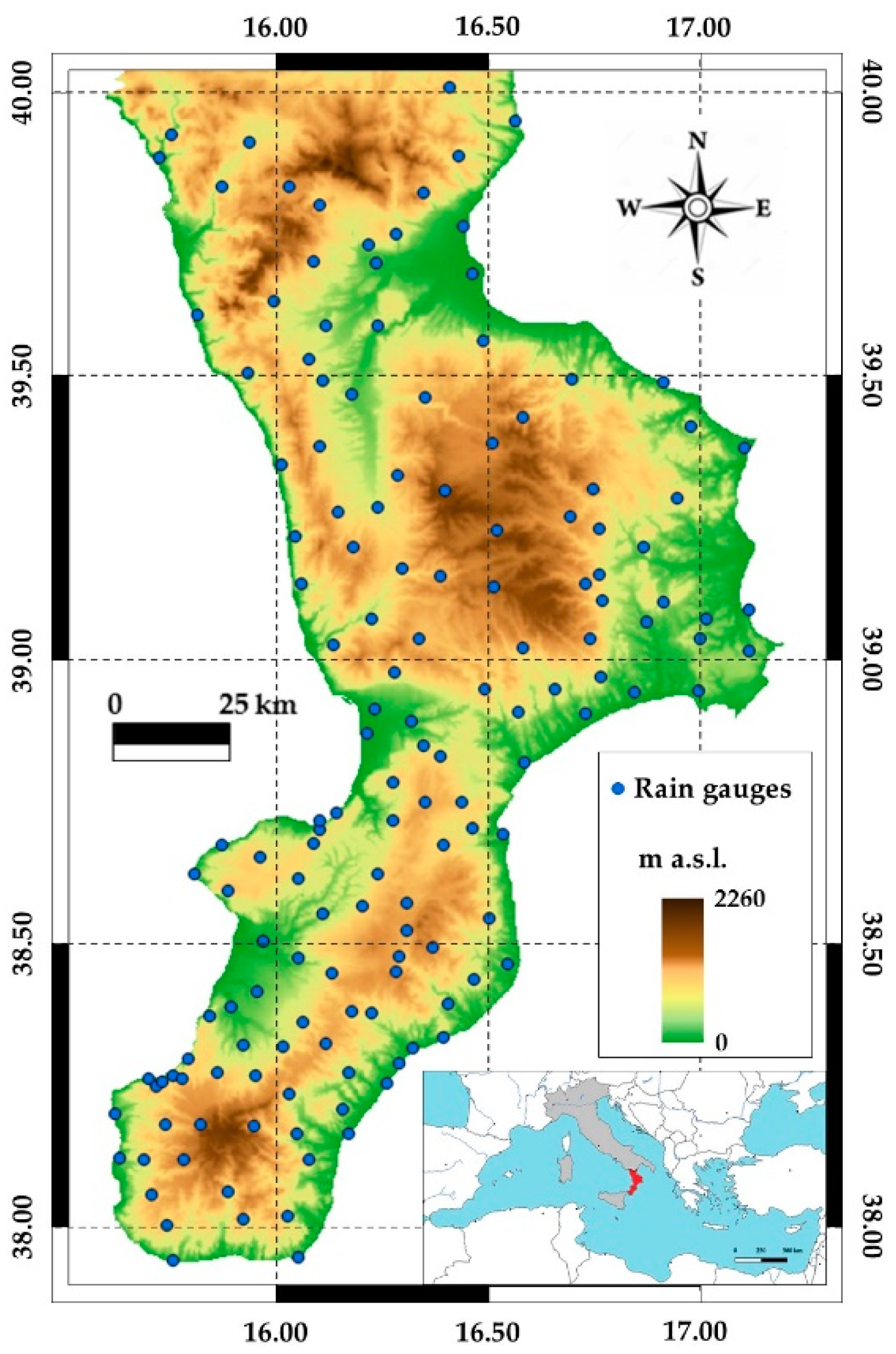


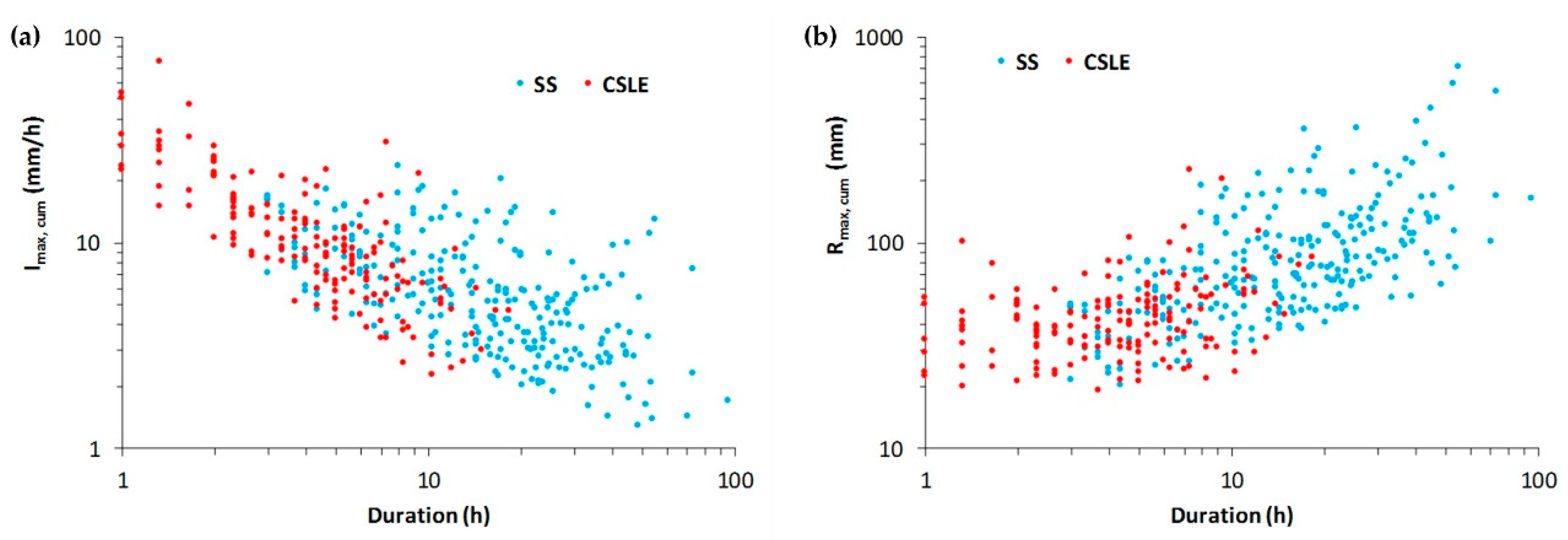
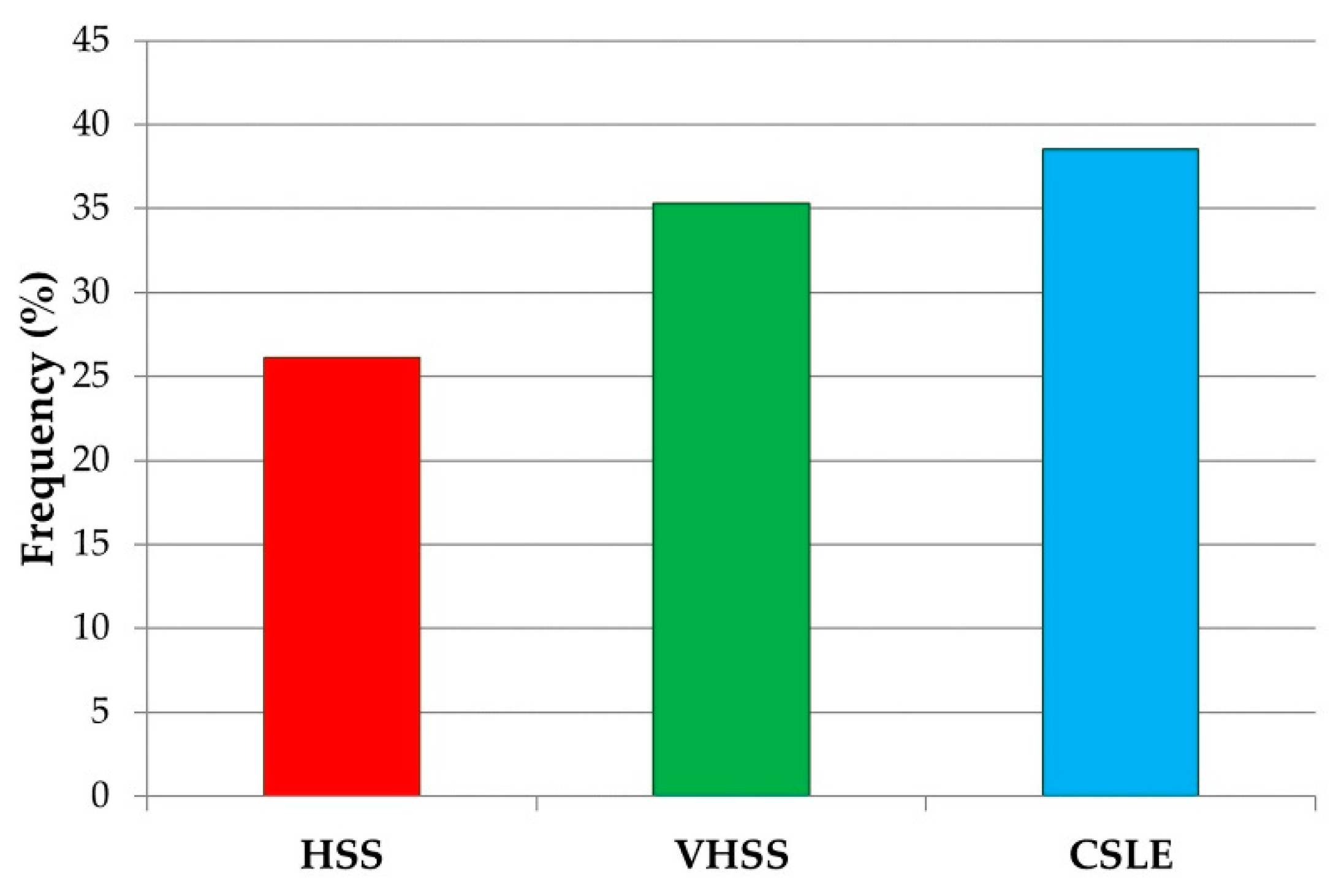
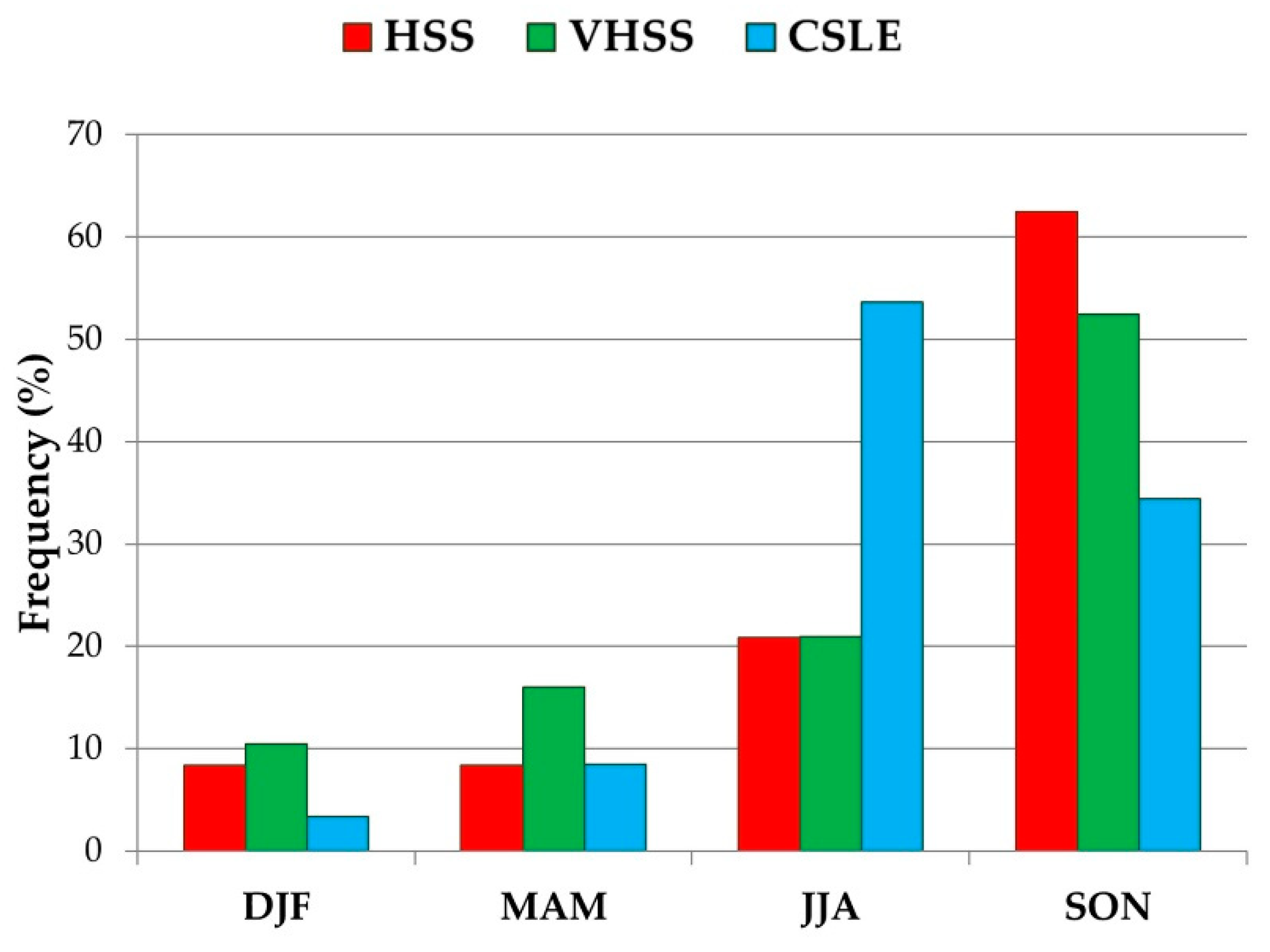
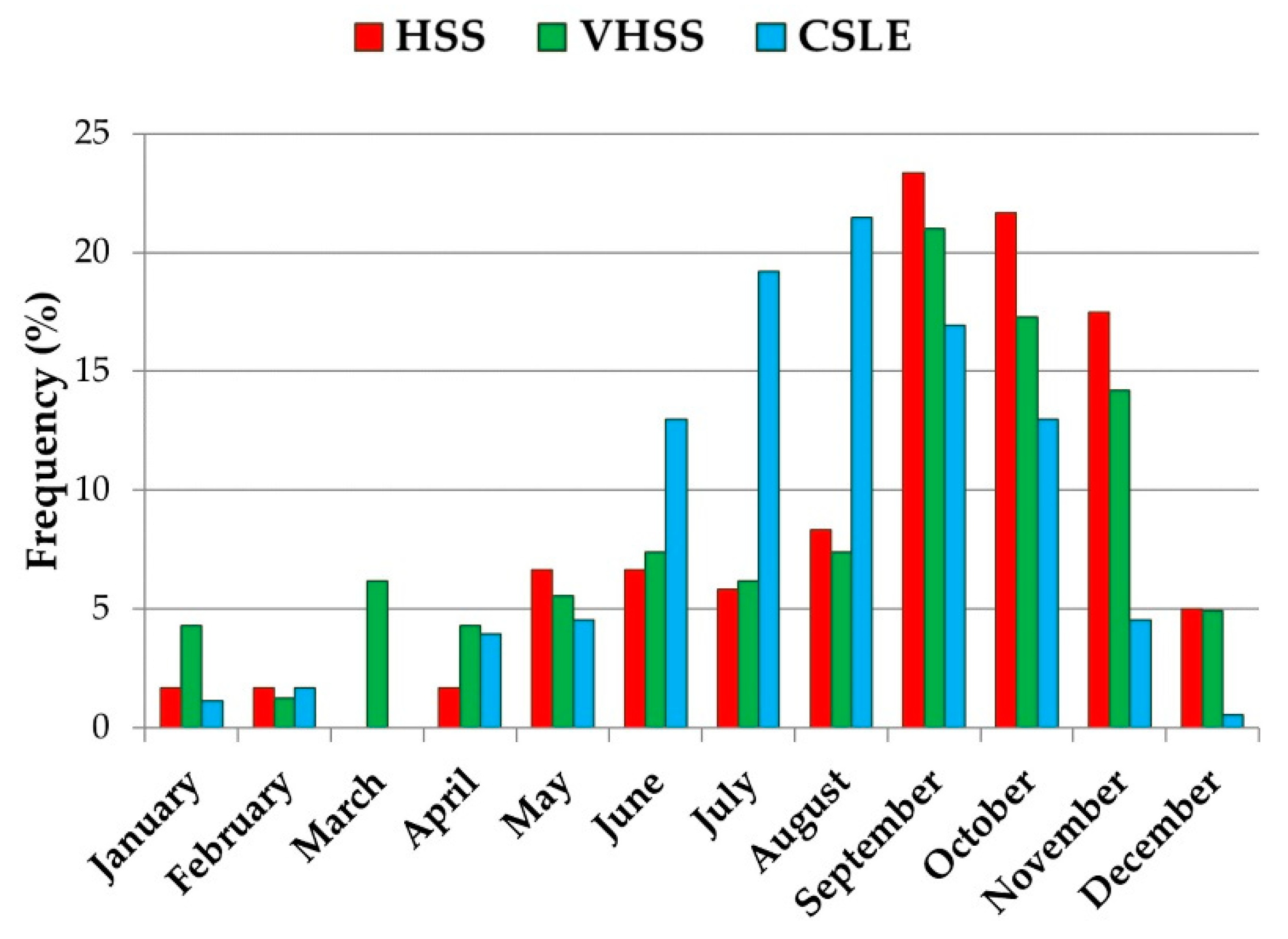


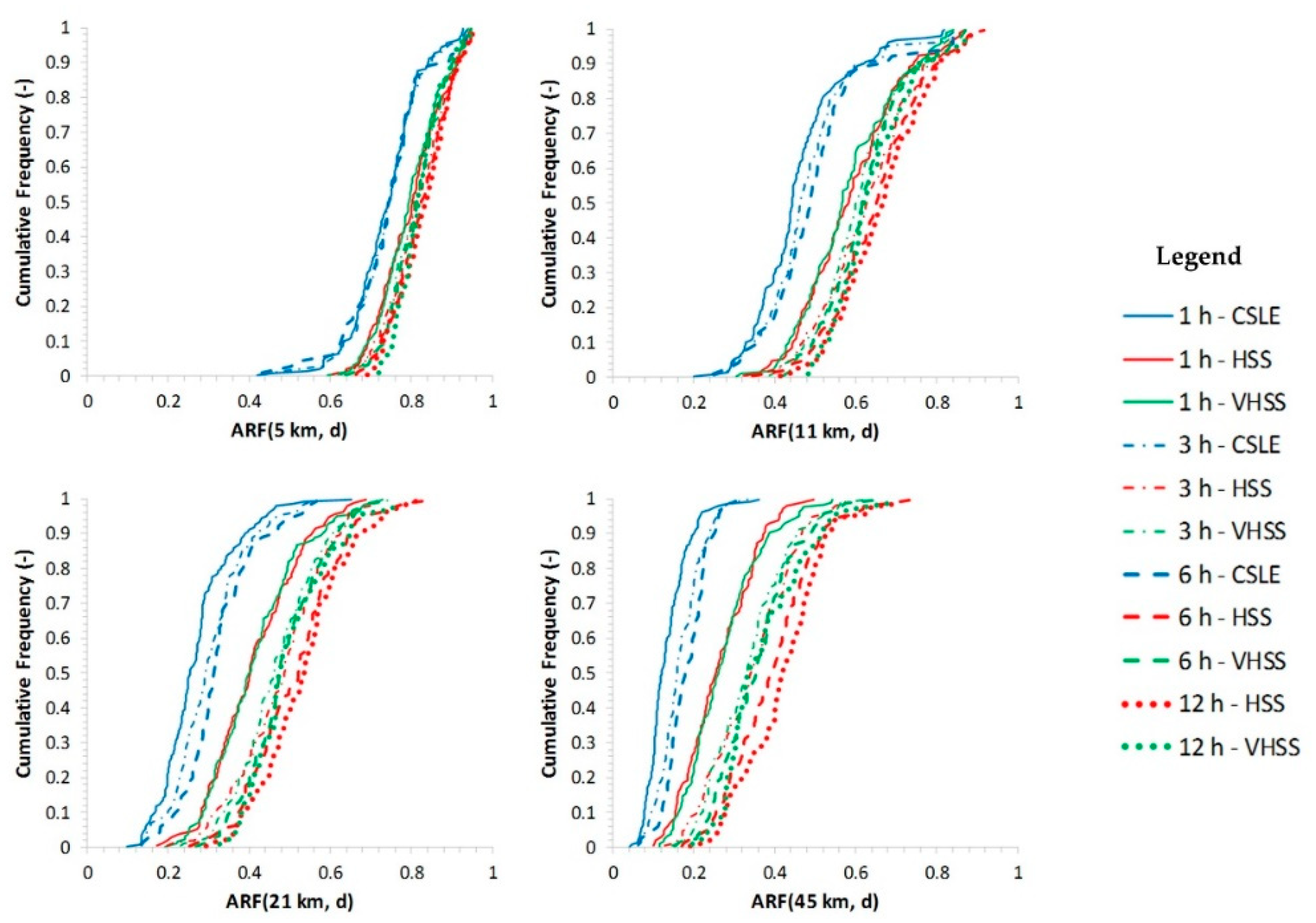

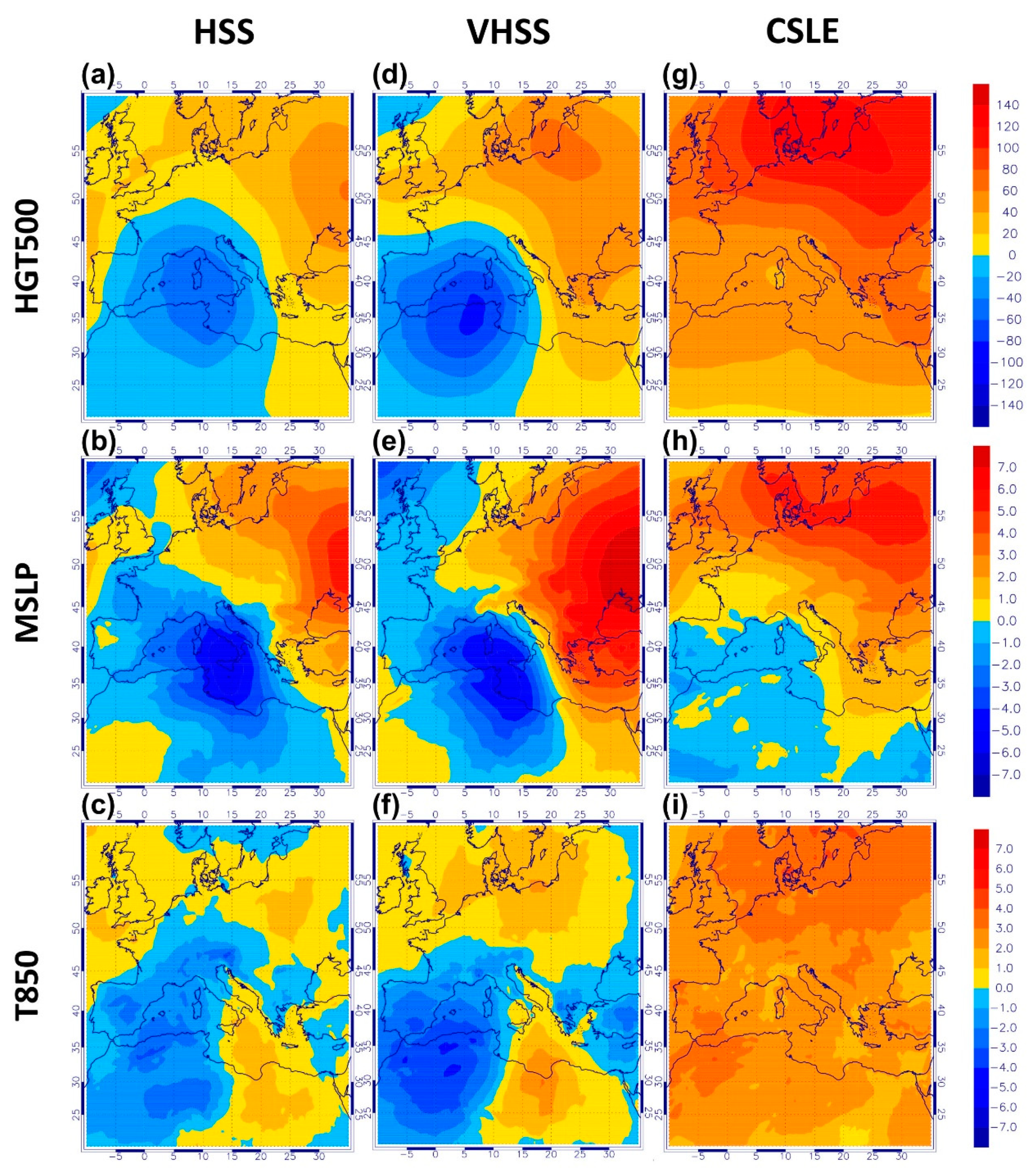
| MONTH | Number | % |
|---|---|---|
| January | 11 | 2% |
| February | 7 | 2% |
| March | 10 | 2% |
| April | 16 | 3% |
| May | 25 | 5% |
| June | 43 | 9% |
| July | 51 | 11% |
| August | 60 | 13% |
| September | 92 | 20% |
| October | 77 | 17% |
| November | 52 | 11% |
| December | 15 | 3% |
| TOTAL | 459 | 100% |
| SEASON | Number | % |
|---|---|---|
| DJF | 33 | 7% |
| MAM | 51 | 11% |
| JJA | 154 | 34% |
| SON | 221 | 48% |
| TOTAL | 459 | 100% |
| Start | End | Max Peak (mm/20 min) | Max Peak Rain Gauge | Max Cum (mm) | Max Cum Rain Gauge |
|---|---|---|---|---|---|
| 22 October 2005 18:00 | 23 October 2005 1:00 | 51.2 | Molochio | 224.0 | Molochio |
| 25 September 2006 22:20 | 27 September 2006 18:40 | 43.0 | Monasterace—Punta Stilo | 131.0 | Giffone |
| 6 November 2014 11:40 | 6 November 2014 12:20 | 25.8 | Cropani | 265.8 | Cardeto |
© 2020 by the authors. Licensee MDPI, Basel, Switzerland. This article is an open access article distributed under the terms and conditions of the Creative Commons Attribution (CC BY) license (http://creativecommons.org/licenses/by/4.0/).
Share and Cite
Greco, A.; De Luca, D.L.; Avolio, E. Heavy Precipitation Systems in Calabria Region (Southern Italy): High-Resolution Observed Rainfall and Large-Scale Atmospheric Pattern Analysis. Water 2020, 12, 1468. https://doi.org/10.3390/w12051468
Greco A, De Luca DL, Avolio E. Heavy Precipitation Systems in Calabria Region (Southern Italy): High-Resolution Observed Rainfall and Large-Scale Atmospheric Pattern Analysis. Water. 2020; 12(5):1468. https://doi.org/10.3390/w12051468
Chicago/Turabian StyleGreco, Aldo, Davide Luciano De Luca, and Elenio Avolio. 2020. "Heavy Precipitation Systems in Calabria Region (Southern Italy): High-Resolution Observed Rainfall and Large-Scale Atmospheric Pattern Analysis" Water 12, no. 5: 1468. https://doi.org/10.3390/w12051468
APA StyleGreco, A., De Luca, D. L., & Avolio, E. (2020). Heavy Precipitation Systems in Calabria Region (Southern Italy): High-Resolution Observed Rainfall and Large-Scale Atmospheric Pattern Analysis. Water, 12(5), 1468. https://doi.org/10.3390/w12051468







